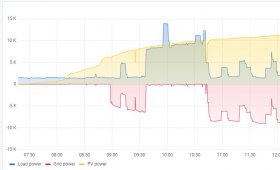HI, I could use some help designing an off grid EV charging station for our Ford Lightning which is scheduled for production. Where I keep getting stuck is on the battery bank sizing. The standard formulas come up with a requirement of over 700 amp hrs of battery. In his video for his Tesla charging Will is only using two 100Amp 48V server rack batteries. I'm retired and we will be able to charge during the day. We will also have a charging station hooked up to the grid, so don't need an 100% solution. Not worried about the rare occasion when we don't have sun for days or if we have to put a lot of miles on a few days in a row. Just looking the 90% of the time solution. Can someone help me understand this battery requirement calculation? Also, we were going to use the same batteries he had, the EG4's.. and the new UL listed MPP 6048 inverter. But, the reviews say that the inverter doesn't work with the EG4's and a number of other issues, so we may have to pivot to a different inverter. We also need to keep the price of the system reasonable, or we are wasting money and might as well just pay PGE to charge it. Would appreciate any advice. -cj- (PS, we are in California on 2.5 acres, and have a site with full sun for the panels, ground mount)...
KWh Demand | |
| Miles Driven/Day | 50 |
| Range (1.8 mi/kwh) | 1.8 |
| Battery used KW | 27.78 |
Solar System Size | |
| Adj for system losses | 29.17 |
| Inverter efficiency | 95% |
| Amt of Elec needed to be supplied by panels to inverter and battery | 30.70 |
| Ave. Irradiation hrs/Day | 6 |
| Solar Panel KW needed | 5.1169591 |
| solar panels needed | 12.792398 |
Battery Bank Size | |
| Energy needed kwh | 27.777778 |
| Depth of Discharge | 80% |
| Battery storage needed KWH | 34.722222 |
| Battery Voltage | 48 |
| Amp hrs (1000xKwh/voltage) | 723.37963 |




